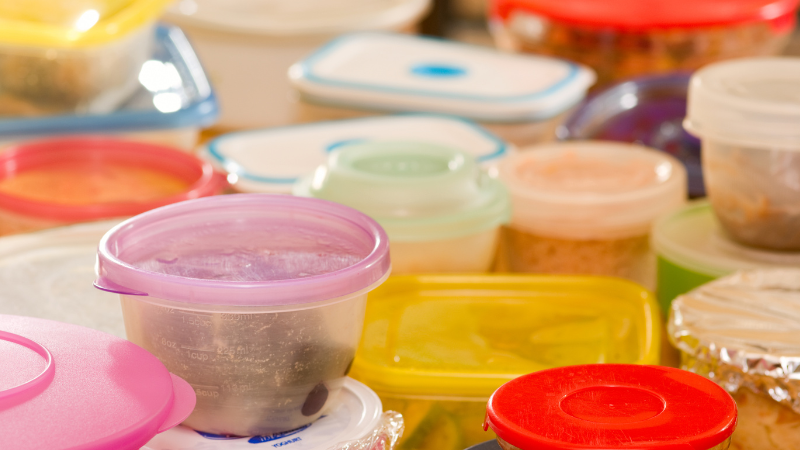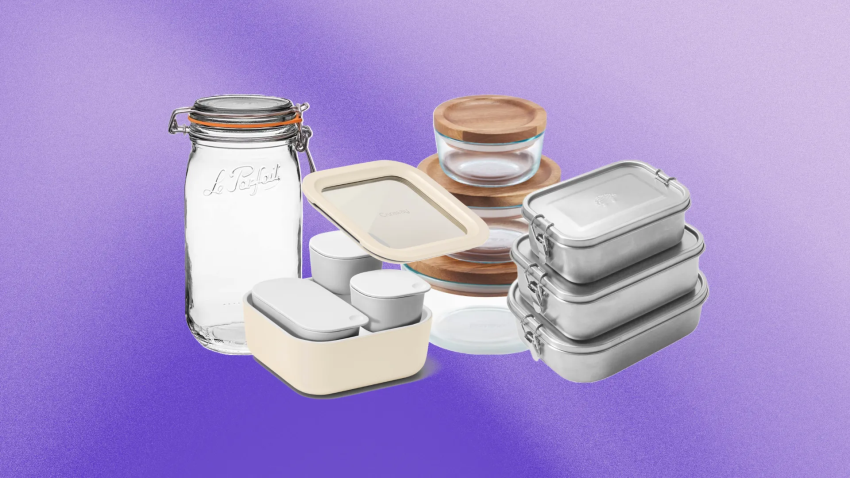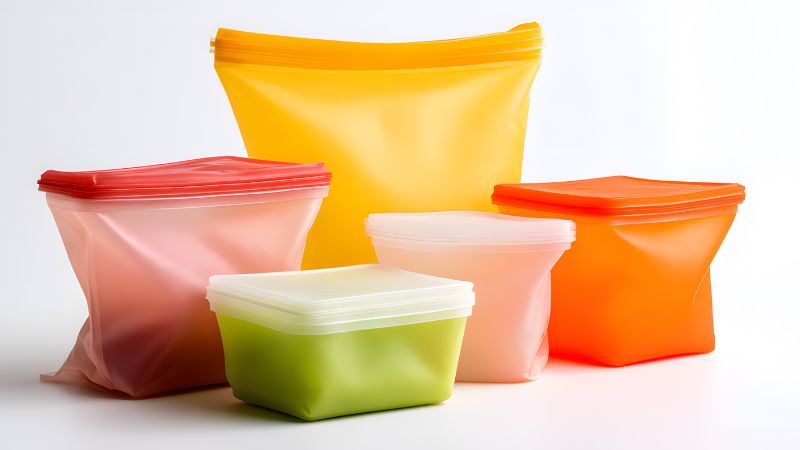Although convenient, plastics also bring some environmental concerns. Hazardous compounds like BPA and phthalates might find their way into our food, especially when heated.
In this blog, we will explore the advantages and disadvantages of plastic food containers. Besides that, you will learn about multiple plastic containers by the end of the blog. Let’s get started without a delay.
What Types of Plastic Can Be Used for Food Containers?

Not all plastic containers are suitable as reusable containers. Some contain toxins, while some are reusable. Let’s look at the types that are safe for storing food.
1. Polypropylene (PP) Containers
Polypropylene (PP) containers are light yet sturdy enough for daily use. We can use them to heat food inside dishwashers or microwaves. These containers are standard for refrigerator food storage bins, medicine bottles, yogurt containers, and meal prep boxes. They are common plastic packaging for storage.
2. Polyethylene Terephthalate (PET) Containers
These translucent lightweight containers package plastic bottles, drinks, juices, and salads. Polyethylene terephthalate (PET) is unsuitable for microwave use but is a relatively highly recyclable material, thus forming part of green plastic packaging solutions. They leave a strong scent of the material stored originally inside them.
3. Polystyrene (PS) Containers

Polystyrene (PS) is also rigid and flexible and offers good thermal insulation properties. It is the best material for storing soups, salads, and even puddings, as cold or hot foods require insulation. However, PS does not have high-temperature resistance. It makes them unfit for microwave application.
4. Polyvinyl Chloride (PVC) Containers
Flexible Polyvinyl Chloride (PVC) containers are long-lasting and effective in preserving food. They are best at improving shelf life. The typical storage examples of these containers include deli meats, cheeses, or baked items. However, Polyvinyl Chloride (PVC) may contain harmful substances and is unfit for microwave oven use.
5. High-Density Polyethylene (HDPE) Containers
These are often solid and rigid. So they can store different foods like oils, sauces, dry goods, or processed meals for a long time. They are primarily non-descriptive, and you can keep them inside a fridge and on shelves. High-density polyethylene containers are mostly food-grade but are sometimes not the easiest to sanitize.
Inquire About Our Silicone and Plastic Products!
Pros of Plastic Packaging Containers
There are many benefits of using plastic containers for storing edibles. That is why they are preferable for most people for the transportation of food. In this section, we will explore some advantages of plastic packaging for eco-friendliness and why customers choose it.
- Toughness: Plastic food containers are solid. Unlike glass or ceramic ones, they cannot break easily on impact. This property makes them a perfect fit for daily usage, such as storing leftovers in the refrigerator, packing snacks, and arranging the pantry.
- Affordable: A critical factor about plastic boxes is their cost-effectiveness. They are much cheaper than glass and stainless-steel equivalents. It makes them suitable and promising solutions for preserving food.
- Lightweight: Plastic packaging is lightweight and easy to carry. It is perfect for grocery bags, including takeouts on picnics or campsites. We can enjoy our favorite meals without carrying a heavy weight and increase their shelf life.

- Diverse Use: They come in various shapes, sizes, and forms to suit storage needs and tastes. For example, if you want a small container for single-serving snacks or a big one, there is a plastic container for that, too.
- Resistance: Plastic packaging can withstand acids and non-reactive chemicals. It makes them perfect for the storage of acidic foods without a reaction.
- Recyclable: Some plastic container materials, like PET, are highly recyclable. They are eco-friendly options with the perks of being versatile.
Cons of Plastic Food Containers
With every good thing, something bad is associated. So it is with plastic food containers. Although there are benefits, there are some drawbacks that we cannot ignore.

- Effects on Ecology: Both plastic packaging and plastic bottles are not very friendly to the environment due to their significant carbon footprint. Their hard nature makes them highly difficult to decompose. They contaminate sites such as landfills or oceans, where they can stay for years while threatening marine life.
- Health Concerns: Some plastic containers have hazardous toxins like phthalates and BPA. They can cause various complications, like infertility over time, due to hormone imbalances associated with these components.
- Possibility of Discoloration and Warping: Using plastic food containers is not suitable for the long term. Acidic foods or hot ones can change them. Their aging makes their color wear off or generate odors that would hardly disappear.
Inquire About Our Silicone and Plastic Products!
- Microplastic Contamination: Plastic packaging releases tiny particles known as microplastics. These particles are dangerous for human health and can accumulate in the body. They cause health issues like cancer and inflammation.
- Food Degradation: Many plastics used in manufacturing food containers are fat-soluble. Storing fats in these containers can cause the toxic chemicals to leach into the food. So they become dangerous to consume.
- Recycling Issues: Besides PET, other types of plastic containers are not easily recyclable and are non-biodegradable. To date, we have only recycled 9% of plastic waste. This makes them one of the biggest causes of environmental pollution.
Safety Considerations of Plastic Food Containers

Plastic containers are a blessing, but have an environmental impact and potential health risks. But there should be a way to negate these issues, right? Here is our deep dive into addressing the safety concerns related to these food containers.
BPA-Free Options
Bisphenol A or BPA is particularly used to increase the hardness of the plastic. It can cause hormonal imbalances such as increased testosterone and estrogen levels in the human body. Its hazardous nature has shifted many manufacturers’ focus toward BPA-free options.
These options are much safer but still carry plastic drawbacks. When buying plastic storage containers, always check for BPA-free labels. This way, we can avoid consuming chemicals that affect the body and cause other complications.
2. Microwave and Dishwasher Safe
Not all plastics can withstand microwave oven heat or dishwasher abrasion. Wrong containers may cause warping, melting, or even releasing harmful chemicals into nature.
That’s why the United States Department of Agriculture directs the use of microwave-friendly food containers. Unlike single-use containers, they do not leach chemicals at high temperatures.

It is better to wash plastic containers by hand. But if you want to put them inside a dishwasher, look for containers with a “dishwasher-safe” label. Avoid putting those inside the dishwasher with scratches, cracks, and worn-out surfaces when washing them.
3. Avoiding High-Temperature Foods
Using plastic food packaging to store leftovers is ideal. However, it is essential to consider the temperature of our food when stored inside plastic food packaging.
Hot foods increase the chance of chemicals in plastics mixing into your meal. Allow the food to cool before putting it inside the plastic food packaging to ensure the plastic doesn’t reach temperatures that could trigger chemical leaching.
Alternatively, consider transferring them to a glass or stainless-steel container. These materials are generally considered safer for storing hot food. When feeling environmentally responsible, choose plastic packaging made from plastic thermoforming. This recycled content is environmentally friendly due to its recycled nature.
Inquire About Our Silicone and Plastic Products!
Alternatives to Plastic Containers
Plastic food packaging materials have a large carbon footprint and environmental impact. They are toxic to health. But the trend is toward better, safer, and more environmentally friendly choices like paper packaging. These top three alternative packaging materials for the food industry enable you to make the best choice for your kitchen.
1. Glass Containers
Glass packaging is non-porous and prevents chemicals from seeping through its surface. Unlike other materials, glass does not get stained or smell bad. Cleaning glass packaging products requires less effort and is also microwavable (without a lid).
Indeed, glass bottles allow you to see what is inside due to their impeccable transparency. Glass packaging can come in different designs and sizes and accommodate food such as salads.

2. Stainless Steel Containers
Stainless steel stands out when considering its durability. It hardly dents or scratches unless it is of great height! Compared to glass and metal containers, stainless steel weighs less.
It makes their transport more accessible. Stainless steel serves well as a heated and chilled food waste storage medium. Some models can go right into an oven. They look cooler than other alternative materials.
3. Silicone Containers
Silicone containers are best for flexibility and elasticity. They collapse into themselves and save storage space. These containers are lighter than glass and stainless steel and can cope with the heat, i.e., microwave ovens and freezers.
Their tight-fitting covers help to travel with liquids without any leakage problems. It reduces bubble wrap and shipping costs. Overall, silicone containers are flexible, utility-packed, and carry food in tricky situations.
Inquire About Our Silicone and Plastic Products!
Why Should You Use Plastic Food Containers?
Plastic food containers are necessary as they serve the purpose of storage and protection. Plastic packaging contributes many benefits that make it popular among consumers. Here are some reasons:
1. Durability and Safety
Unlike a glass container, plastic food packaging won’t smash when dropped. It makes them safe to use near kids or when traveling. Therefore reduces the chances of injuries and cuts from broken glass.
Plastics used for food containers are strong enough to withstand daily activities without becoming damaged. They do not crack like glass, even if subjected to occasional jostling.
2. Freshness and Storage
Bacterial proliferation can cause food to decompose. Plastic packaging items have a fitting lid. The lid prevents air and moisture from entering. It preserves the food’s freshness according to industry standards and avoids spoilage. Additionally, airtight, high-quality seals prevent potential health risks of leakage or spillage.
3. Convenience and Practicality

Plastic food packaging is mostly microwave-safe. That makes reheating leftovers more convenient. Since you don’t have to transfer food from one dish to another, cleaning them is easy, too!
Besides that, many plastic food packaging materials are dishwasher safe than glass. Hence, no hand washing saves time and energy. Being much lighter than glass or metal containers means that plastics are practically the best option for packing.
4. Recyclable
There is an increasing percentage of plastic recycling happening worldwide. The ability of plastics to create new products makes them a reliable choice. Some plastics, like PET, are biodegradable, making them highly practical.
So they are safe to use without concern about polluting the environment. Their recycled nature entitles them to use plastic for food containers.

Conclusion
Here’s a concise version of your paragraph, keeping the core meaning:
Plastic food containers are convenient, affordable, and lightweight, but they also pose environmental and health risks. Choosing recyclable, BPA-free options and mixing in eco-friendly materials like glass or stainless steel can reduce these concerns. A balanced approach with more recycling ensures safer, sustainable food storage.
Go Sustainable with Hongju and Reduce Plastic Waste
Looking for eco-friendly silicone or recycled plastic products? At Hongju, we produce with a lighter footprint and use large amounts of recycled materials through plastic thermoforming.
We understand the damage plastic waste can cause, so we focus on turning it into practical, sustainable solutions. Get in touch and let’s find ways to grow your business while helping the planet.